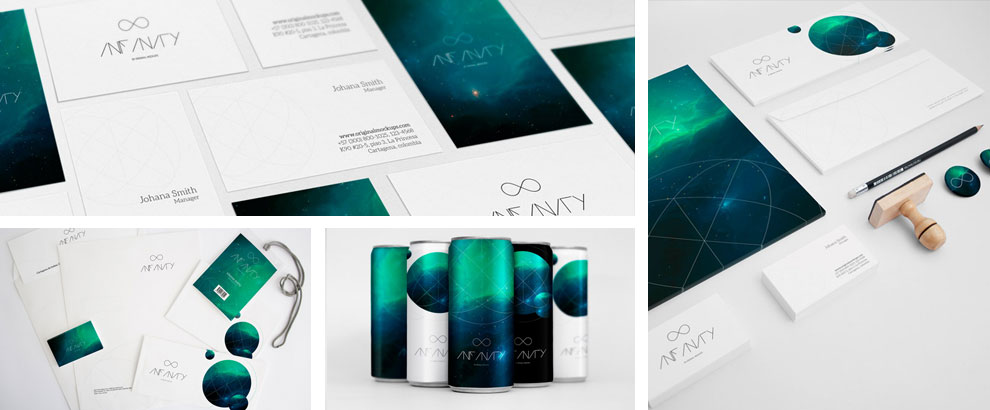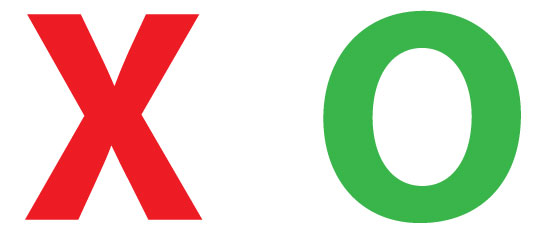
Visuals only hold the value that we give them. With no context, a shape is just a shape. Though it may serve many purposes in many forms, from complex geometry and math to the rich history of a 200-year-old brand, a shape on its own won’t tell your audience a story.
Suppose we took a shape and placed it with another to give it context:

In this instance, we can note that the shapes aren’t the same, but they appear to have similar weight and value. What happens if we distinguish them further?

Now we can assume more about these two shapes. They’re different colors and different shapes. They must be opposites.
It happens often. You’ll view an object that you haven’t encountered and make inferences about its use based on your personal experiences. The same happens with brand visuals. How can we influence our audience to make positive assumptions about us? How do we make sure that they view us in a good light, even if they’ve never interacted with our product?
1. Intentional Design
Like in the above example, we naturally make assumptions based on related experiences. It’s likely that we viewed the red “X” as a negative symbol, and the green “O” as a positive symbol. These exist for many other symbols, characters and even colors. It’s important that we bear in mind the suppositions that can be made about a brand.
Fortunately, designers have the edge. They have their own experiences in what has worked to connect with target audiences and what hasn’t, and can bring these experiences back to you. A designer’s real expertise is their ability to put themselves in the perspective of someone who has had baseline exposure to your products. In combination with the knowledge of their target market, designers have the opportunity to shape consumers’ opinions and future expectations of your brand.
2. Coherency
Visuals should obviously fit with company messaging: Composition is appropriate to the designer’s medium, color palettes appropriate to the unique target market and everything from front to back works toward the overarching goal. But as they say, “the devil is in the detail.”
What’s not so obvious is that a brand should be descriptive of its origins and convey your goals in the market. A brand should put a face to a product, service or organization. And when potential consumers look at the competition, they should be able to clearly see the difference in the experience your product can offer.
3. Design for People
One of the things that is not stressed enough is that people are going to be the ones viewing any branding you execute. When determining what “personality” a brand conveys, consumers often hope for something “tech-y” or “friendly” or “fun – those descriptors are a few of many, of course.” A successful brand will find ways to tie these themes back to the people in its market. It’s important to keep reminding yourself that your brand isn’t trying to appeal to your competitors.
As a designer, a good measure of success is the ability to provoke emotion, whether a simple positive/negative reaction like, “this is nice,” or nostalgic feelings, like remembering the color shirt your first date wore to the movies. Emotion is a good indication of success because it lets us know if and how people are making a connection to a brand. Keeping a brand too “market-centric” prevents doing so on a larger scale.
4. Flexibility
A flexible brand keeps things from becoming stale and brings a human quality to any and all of its messaging and collateral. Brand flexibility can open the door to many opportunities, and great brands can translate across multiple platforms simply and effectively. A successful brand will have a clear, recognizable and consistent message throughout.
It’s often difficult to tell what’s coming around the corner. Sometimes a series of events – planned or otherwise — could lead you to huge growth or opportunity to reach a larger audience. Going through the effort of a rebrand could be costly or untimely. When developing a brand, it’s hard to be conscious of the unknown, but leaving your visuals flexible can set you up early for success.
5.Continuity
Like a great brand translates across platforms, a great brand can also translate across multiple generations. A brand can go through multiple rebrands and changes in messaging but always remember the brand is about the product or service. Keeping this in mind will help develop a consistent brand.
Continuity is the bridge between the visual and non-visual elements of your brand. This includes everything from the product, messaging, history, imagery and color scheme. Though these elements may change, the bridge that brings them together should not.
Need some examples of great visual brands? Visit our page to get our take on effectively approaching and building a brand. Or, comment below and tell us if you have any tips.




 Grant Wright
Grant Wright





 Corie Fiebiger
Corie Fiebiger
 Shae Geary
Shae Geary Roman Lukjanenko
Roman Lukjanenko Phelan Riessen
Phelan Riessen Katrina Early
Katrina Early Hamish Marshall
Hamish Marshall